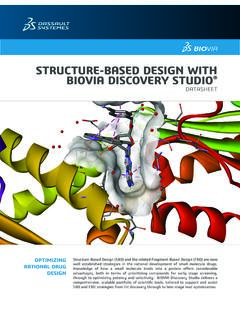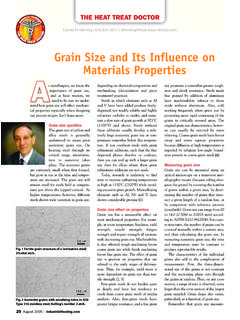Transcription of BIOVIA MATERIALS STUDIO DMOL
1 BIOVIA MATERIALS STUDIO dmol3 is a modeling program that uses density functional theory (DFT) to simulate chemical processes and predict properties of MATERIALS both rapidly and accurately. Because MATERIALS STUDIO dmol3 can predict processes in gas phase, solution, and solid environments, it is broadly applicable to research problems in chemistry, pharmaceuticals, MATERIALS science, and chemical engineering, as well as solid state physics. Researchers can use the program to investigate the nature and origin of the chemical, electronic, and structural properties of a system without the need for any experimental input.
2 Use MATERIALS STUDIO dmol3 to perform virtual experiments, leading to tremendous savings in costly experiments and shorter developmental DOES MATERIALS STUDIO dmol3 DO?Researchers in chemistry, pharmaceuticals, and MATERIALS science may be tasked with a number of challenging goals like the development of new compounds, such as a more efficient catalyst or a more effective medicine; or they may need to improve a manufacturing process by determining a more efficient synthesis pathway; or they may be faced with simply understanding and describing fundamental processes, explaining why one particular material is better than another.
3 Modeling can address all of these challenges, provided that the method is fast and accurate. MATERIALS STUDIO dmol3 is just such a STUDIO dmol3 is a DFT program with a long track record of successful commercial applications. With its unique approach to solving quantum mechanical equations, MATERIALS STUDIO dmol3 has long been one of the fastest methods available for performing calculations, an advantage that becomes apparent especially for larger systems, those with over 500 its ability to model both molecular and solid state problems, the application provides a way to study the broadest possible range of problems in a single package.
4 The method is equally well suited to performing a conformational analysis of a small molecule as it is to modeling catalysis on a metal program can be used in areas such as pharmaceutical drug discovery to model ligand binding or in drug development to understand crystal polymorphs. Use MATERIALS STUDIO dmol3 to design new metallocene catalysts for polymerization, or to understand the mechanism of supported metal catalysts. You can even use MATERIALS STUDIO dmol3 to predict band gaps and design new solid state STUDIO dmol3 has been applied to such diverse research problems as homogeneous catalysis, heterogeneous catalysis, semiconductors, molecular reactivity, and combustion technology.
5 Example applications include the study of the process of chemical vapor deposition, understanding the action of automotive catalysts, explaining the mechanism of polymerization reactions, and investigating combustion techniques under extreme STUDIO dmol3 s emphasis is on speed without compromising quantum mechanical accuracy. An efficient geometry optimization algorithm lets you predict minimum energy structures rapidly. A transition state search employing a combination of LST/QST algorithms facilitates the evaluation of energy barriers.
6 Reaction rates for use in BIOVIA MATERIALS STUDIO Cantera chemical dynamics calculations can also be generated using the dmol3 Reaction Kinetics task. Using parallel versions of the MATERIALS STUDIO dmol3 code, large problems can be MATERIALS STUDIO dmol3 DATASHEETThe geometry and highest occupied molecular orbitals (HOMO) of two structures optimized in MATERIALS STUDIO dmol3 . The top structure is caprolactone, a monomer use in the production of artificial skin. The lower structure is Al(OH)3, which can initiate ring opening. MATERIALS STUDIO dmol3 can be used to predict the mechanisms of ring opening and MATERIALS STUDIO ADVANTAGEM aterials STUDIO dmol3 is part of the MATERIALS STUDIO software environment.
7 MATERIALS STUDIO provides a user-friendly interface, complying with Windows standards. MATERIALS STUDIO Visualizer, the core of MATERIALS STUDIO , offers a wide range of model building and visualization tools that allow you to construct rapidly models of the systems of interest, easily select MATERIALS STUDIO dmol3 , and run an advanced quantum mechanics calculation. The simple user interface together with BIOVIA s training programs ensure that even new users will be able to use the program with flexible client-server architecture means that calculations can be run on servers located anywhere on your network.
8 Results are returned to your PC, where they may be displayed and analyzed. You can easily produce high quality graphics of molecular and MATERIALS structures, molecular orbitals, electrostatic potentials, or charge densities. Structures, graphs, and other data such as video clips produced from MATERIALS STUDIO dmol3 output can be instantly exchanged with other PC applications, assisting you when sharing them with colleagues or when analyzing them using spreadsheets and other setup allows the method to be applied in a high-throughput environment, performing multiple, repetitive calculations easily, and storing the results in a table.
9 Subsequent statistical analysis can reveal hidden structure-property relationships that can be easily exploited to design new MATERIALS or explain behavior on the molecular DOES BIOVIA MATERIALS STUDIO dmol3 WORK? MATERIALS STUDIO dmol3 achieves its speed and accuracy by using numerical functions on an atom-centered grid as its atomic ,2 The atomic basis functions are obtained from solving the DFT equations for individual atoms and are hence quite accurate. The high quality of these basis sets minimizes basis set superposition effects and allows an improved description of molecular electron density in MATERIALS STUDIO dmol3 is expanded in terms of multipolar, atomic-centered partial densities.
10 This provides a compact yet highly accurate representation of the density, and allows for a good scaling with growing system size. Consequently the evaluation of the Coulomb potential scales linearly with the size of the system. The Hamiltonian matrix elements are calculated by using a sophisticated numerical integration algorithm that also scales algorithms in MATERIALS STUDIO dmol3 allow for very efficient parallelization of the numerical integration procedure. MATERIALS STUDIO dmol3 can perform both All Electron or pseudo-potential calculations.











